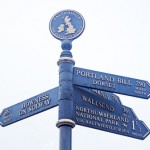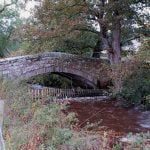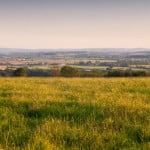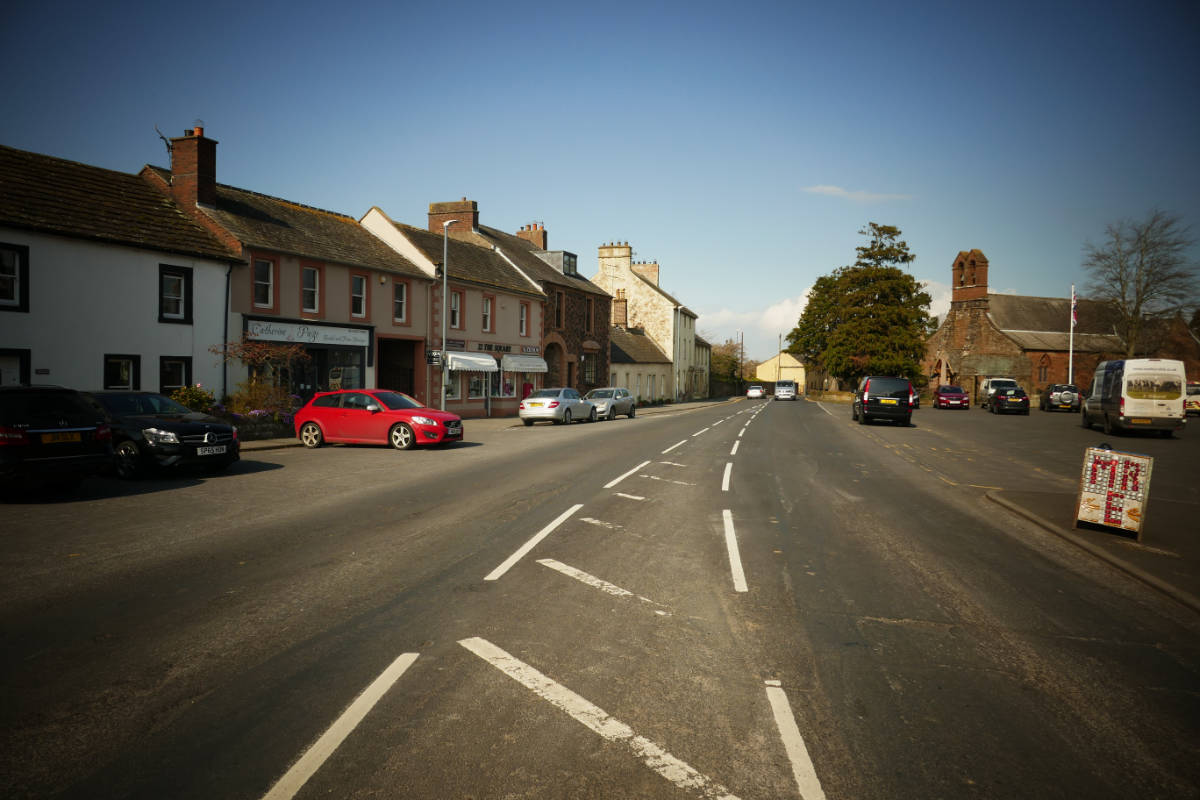
Dalston Cumbria
Dalston, Cumbria, is a great place to visit. Being only 4 miles from Carlisle and boasting its own spooky attraction, Dalston Hall.
The village and civil parish are situated within the Carlisle district of Cumbria, North West England. The village is located a little over 4 miles (6 km) south of Carlisle and approximately 5 miles (8 km) west of Junction 42 of the M6 motorway. Most of the ‘old’ village is strung out along a mile section of the B2599 road, which runs from the (village) ‘Square’ to the hamlet of Bridgend. The B2599, the parish’s arterial road, also lies close to the west bank of the River Caldew, where it passes through Dalston. At the 2011 UK census, the population of Dalston was recorded as 2590, with that of the wider parish being 6,051.
Go to the Cumbria Business Directory
Dalston – A Fleeting History
There is convincing archaeological evidence suggesting a Roman presence in the parish of Dalston during their occupation of Britain. Most experts agree that it’s probable there was a Roman encampment of some kind at Stockdalewath.
Nevertheless, the known story of Dalston doesn’t really start until around 1092, when William Rufus, son of William the Conquer, captured Carlisle from the Scots. The area, which now roughly relates to the Parish of Dalston, was quickly established as one of the 11 baronies of Cumbria, with the ‘*de Dalston’ family being bestowed the land. However, their tenure as the local Lords of the Manor was relatively short-lived since, in 1139, the Scots took back Carlisle and the surrounding area.
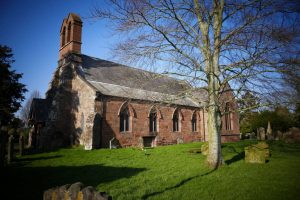
St Michael’s 18th-century church
Daleston – The early Dalston
The first written reference to the village of ‘Daleston’ was made in 1187 when the resident ‘bonded’ tenants were recorded as paying Henry II a total of £10 6s 4d in rents. Over the next few centuries, the village name was alternatively spelt as Dalestun, Dalleston, Dalliston and Daweston, before ‘Dalston’ was finally settled on. The name is of Viking heritage, where ‘dal’ meant ‘dale’ or ‘valley’, or alternatively, it may have been derived from an Old Norse personal name, such as Dall, Dealle or Dali. ‘Ton’ simply translates to English as ‘field’ or ‘enclosure’.
Stressing the parish’s importance, King Richard I appointed a rector to Dalston at the end of the 12th century. In 1230, the Bishop of Carlisle was assigned by the monarchy as Lord of the Manor for the Parish of Dalston.
In 1233, Bishop Malclerk took up residency in the parish at Rose Castle, close to the hamlet of Raughton Head. The succeeding bishops of Carlisle would continue to preside over Dalston up until the 1840s, although take residence at Rose Castle, ’til 2009. The first church in the village was probably built on the site of the current St Micheal’s, a little time after and the completion of Rose Castle. The present church was built around 1750 and largely restored in 1850. Two former Bishops of Carlisle are buried in its graveyard.
Pilgrimage of Grace
On 23rd October 1536, a significant event took place in the Parish when some 15,000 men mustered at Broadfields. Their purpose was to show support for the Pilgrimage of Grace, the North of England uprising that rallied against Henry VIII’s Dissolution of the Monasteries. Thomas Dalston of the local manor, Dalston Hall was present at a like gathering 18 miles away at Moota, where a plan was hatched to seize Carlisle. Later, Dalston was elected as one of a four-man deputy that went to Carlisle to secure a truce for the rebels.
He was obviously a smooth talker, since he subsequently received a ‘Letter of Commendation’, from Henry’s Chief Minister and principal architect of dissolution, the notorious Thomas Cromwell. The letter stated: “he had done good service in the time of the rebellion”. Evocatively, within 8 years, Dalston had managed to acquire the manors of five other Cumberland parishes.
Post-Middle Ages Dalston
In the 16th century, the majority of the population of Dalston were still ‘bonded’ (aka ‘unfree’) tenants and their families, living off the land, but had barely able to scrap a living due to the onerous feudal system. However, apart from farming, the only other real source of employment in the village for the poor was breaking up stones for road making.
By the 17th century, the baronial powers of the church and manors had begun to break down, only to be exacerbated by the outbreak of the English Civil War in 1642. The lot of the Dalston tenant farmer, as with the rest of the country, began to improve, as gradually, it became possible for some to own land and inherit property. By this time, water power from the fast-flowing River Caldew was being utilised to drive the wheels of the new-fangled mills, that were now springing up across the parish. These mills included the likes of Bishop’s Mill, Walk Mill and Low Mill – the names of which have been retained to this day in the village’s development.
Industry Arrives
By the latter half of the 18th century, Dalston had become a relatively prosperous farming community, with a fast-growing population. The mill races which had initially been created to power Dalston’s corn and forge mills were now being utilised to drive the newly found cotton industry. Notably, in 1802, the imposing four-storey Ellers Cotton Mill was built just north of Riverside. However, the building wasn’t to everyone’s liking, especially the noted romantic poet Samuel Taylor Coleridge. Passing through Dalston on a visit to Rose Castle with friends William and Dorothy Wordsworth, he described the mill as a ‘’Sodom and Gomorrah Cotton Manufactory’’.
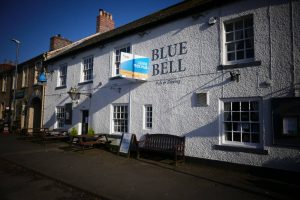
The ‘Blue Bell’ is one of the parish’s oldest buildings dating to the late 16th century
Education in Dalston
In 1815, the village’s first educational establishment was founded when a Grammar School was built along ‘The Green’, by public subscription. It was a fee-paying school that was open to all, but children of the parish got to attend at much-reduced rates.
In 1831, the parish population peaked at 3023. After that, the impact of the Industrial Revolution saw Dalston follow the national trend, whereby rural workers began to migrate to urban centres for better-paid employment. However, in 1844, a major positive change came to Dalston when it was made a stop on the newly opened Maryport to Carlisle railway
It 1853, a National School was opened in the village by the local vicar for children of 7 years old and upwards. The fees were 2d (less than 1p) per week for children of working-class families and 4d for others. In 1860, a purpose-built National School opened, which is now St Michael’s, Church of England, Primary School.
Mills in Dalston
By the 1860s, Dalston had several other cotton mills to rival Ellers Mill, who were important employers in the village. The most notable was the huge Buck’s Mill at Low Green. However, the factory always struggled with profitability and closed after just 20 years, moving to Dentonholme in Carlisle in 1884. However, as life in the parish continued to improve in many respects, the population continued to fall. In 1881, the population of the whole parish was only 2,448, representing an 18% fall on the numbers 50 years earlier.
By the mid-19th century, perhaps a measure of Dalston’s growing prosperity could be seen in the number of pubs in the parish. There were five in the ‘Square’ alone, several more throughout the rest of the village, and another handful spread across the parish. The surviving Blue Bell in the ‘Square’ is now one of the oldest buildings in the village, dating to around the late 16th century.
20th Century Dalston
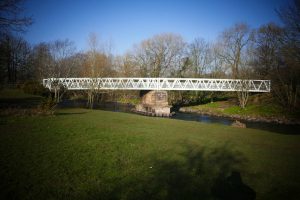
Dalston’s local landmark ‘The White Bridge’ was rebuilt in the 1990s as a footbridge
In 1899, the locally famed ‘White Bridge’ was built across the River Caldew. It was largely funded by the owners of Ellers Mill, the Cowans, who stood to benefit from the ease of transfer of their products from the factory to the railway station. However, in 1901, the business, by then a major Dalston employer, suffered a big setback. The Mill was struck by lightning causing a major fire that gutted the building. It was totally rebuilt, this time as a two-storey building, with the factory, then switching its focus from textile production to that of cotton wool and wadding.
Locally, the works then became better known as “The Cotton Wool Factory”, rather than Ellers Mill. The factory survives to the present day, albeit in a modest capacity.
Lagging much of the country, it wasn’t until the 1920s that Dalston was able to obtain a basic water supply, sewerage system and street lighting. In 1922, the village got its first indoor public room, when the Victory Hall was opened, with much of the money being raised through donations. By this time, mechanisation and better farming techniques were reducing the need for farm labour. And, for some at least, Carlisle and beyond, offered the prospect of better-paying jobs.
By 1925, there were only 2 pubs left in the village; ‘The Bluebell’ and ‘The Bridgend’. The only other surviving pub in the parish was ‘The Royal Oak’ in the tiny hamlet of Gaitskill, which somehow managed to keep trading until around the late 1980s/early 90s.
The 1930s
In 1931, the population of Dalston parish reached a new low at only 1631, which was 20% lower than it had been in 1801. However, the 1930s saw the beginning of a rise in the parish’s residents when 28 smallholdings were established under the government’s new Land Settlement initiative, mostly in the Lingey/Brownelson area. The scheme was set up in rural areas across the county, to help alleviate the unemployment problem, following the Great Depression. Although the project was pretty much deemed a failure from the outset, the Land Settlement Association wasn’t disbanded until 1983, which saw the houses then sold off, mostly to their sitting tenants.
It was only in the 1930s, again trailing national development, that the village finally obtained a gas and electricity supply. And, like many other places in Britain during the 1930s, the village saw an increase in its housing stock when 20 or so council houses were built at Riverside, just north of Bridgend.
*Norman Lords often adopted the existing place-name of lands bestowed to them as their family name.
Dalston – The Modern Era
The first major expansion of Dalston came in the early 1950s when around 80 council houses were built just above Townhead, which was named the Madam Banks estate, after a house (and one-time resident) that had existed there. In 1959, another major change came to the village when Caldew School, a comprehensive school for 11 to 16-year-olds, opened its doors to around 300 pupils. Today the number has grown to more than 1,000 students.
By 1962, the multi-national food and drink conglomerate Nestles had established a factory in Dalston, on a site opposite Caldew School, initially producing powdered and condensed milk. The site has been continually developed over the years and today the factory employs more than 300 people. The factory’s main products are now instant coffee mixes and powdered whiteners, which it exports all over the world. To supply this market, it buys in more than 60 million litres of fresh milk exclusively from Cumbrian farmers.
Laing’s estate and housing in Dalston
The early to mid-1960s saw another major housing development in Dalston when more than 160 houses were built by Carlisle-based national construction company, John Laing. It was immediately dubbed the “Laing’s estate” or “New estate” by villagers. By 1971, the parish population stood at 2553, a rise of 57% over its 1931 low. A number of further housing developments in the village, particularly over the last 20 years, have seen the parish’s population rise quite considerably.
A major upset for many locals came in the early 1990s when the ‘White Bridge’, due to structural failure, was closed to traffic. It was eventually replaced by a footbridge that opened in 1999. As far as practically possible, the new structure has retained the aesthetics of the old bridge.
How to get to Dalston, Cumbria
By Road
If you are heading to Dalston by car from the South, it’s easiest to turn off the M6 motorway at Junction 42. Take the first turning on to the Newbiggin Road, then head straight about 2 miles to the crossroads at Durdar. Proceed straight ahead at the crossroads, Bridgend is about 3 miles further ahead. Turn right for Dalston village square, a mile further on. From Carlisle, take the B2599 southwards out of town, it’s 4.5 miles to the village square.
By Bus
There’s an hourly bus service from Carlisle operated by Stagecoach. It makes the 5.5 miles to Bridgend, via Cummersdale, before returning to Carlisle, along the same route. The service operates from about 7 am to 6 pm, Monday to Saturday.
By Train
To get to Dalston by train, unless you happen to be travelling from West Cumbria, simply head to Carlisle. Dalston is the first stop on the Cumbrian Coast Line, which runs between Carlisle and Barrow. Trains leave around every hour between 6 am and 10 pm, seven days a week. The journey time to Dalston is about 10 minutes.
By Air
Carlisle Airport is about 11 miles away and offers flights to/from Southend (London), Belfast and Dublin. Newcastle which is 60 miles away is the nearest International airport.
Dalston Living
The heart of the village, “the Square”, overlooked by St Michael’s church, consists of 17th and 18th-century sandstone houses and a few shops that remain substantially unaltered. In all, there are 96 listed buildings in the Dalston parish, including the Grade I listed: Rose Castle and the Grade II listed: Dalston Hall, St Michael’s Church, Hawksdale Hall, and Rose Castle dovecote.
The Barras Lane estate is a small industrial complex to the west of the village, which has continued to develop from its opening in the late 1960s. There are currently tens of businesses housed in 8 or 9 buildings at the site.
While Dalston retains two pubs, The Blue Bell, in the village square; and the Bridgend Inn, the Recreation Field is now the village’s social centre. ‘The Rec’ boasts a bowling club with both outdoor and indoor rinks; a tennis club with 4 hardcore courts, a football pitch, a children’s play area and a purpose-built indoor recreational centre.
Dalston Show
Dalston Show is an annually staged agricultural show, held on the 2nd Saturday in August, at the village ‘‘show field’’, which is located a stone’s throw from the Square. It has a reputation for being one of the best shows of its type in the county. The event has obligatory activities and displays for such shows i.e. stock judging, Cumberland and Westmorland wrestling, terrier racing, equestrian events, vintage vehicles and machinery, pet shows, fancy dress, craft tents, and trade stands, vegetable growing exhibitions, etc.
Dalston ‘Black Reds’
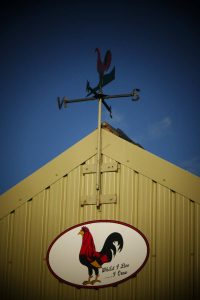
The iconic ‘Black Reds’ emblem can be found around the village
Dalston’s village emblem is a black and red fighting cock, and the village motto is: ”Whilst I live, l crow”. This is a legacy of the village’s past strong links with the sport of cock-fighting. The locally bred Dalston ‘Black Red’ was a notoriously hardy breed of fighting cock whose reputation spread far and wide. In the mid-17th century, the sport was forbidden under the puritanical rule of Oliver Cromwell. But it was a ban, which Dalston ostensibly ignored.
In 1835, the government finally managed to prohibit the sport for good throughout England and Wales. However, it continued in Scotland for another 60 years.
Today, although very much now a rare breed, anyone born, raised, and who continues to live in Dalston is known locally as a ‘Black Red’ (though it’s rumoured the minimum qualifying time is at least 50 years). The premise was even extended to the village football team, who played in the local Carlisle league for many years. The side religiously wore a black and red strip and was known as Dalston Black Reds (presently defunct).
Dalston Hall, The History and, Is It Haunted?
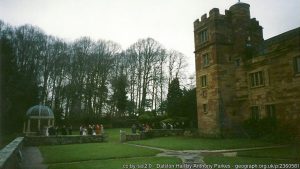
One of the most exciting buildings in the parish, Dalston Hall, is a fortified country house and a Grade II listed building. It was built around 1500 by John Dalston and included a Pele tower and a baronial hall. The house remained in possession of the Dalston family until the mid-18th century. In 1897, the hall was acquired by local entrepreneur Edmund Wright Stead, owner of Stead McAlpin, a textile and printing firm. In 1971, it was converted to its present-day use as a country hotel.
Lady Jane Grey
Dalston Hall has a long and fearsome reputation as being haunted. And not just by one ghost, but a whole host of different entities. However, the most famous is that of the ‘Nine-Day Queen’, Lady Jane Grey. A little time before being executed for treason at the Tower of London in 1554, Lady Jane managed to fit in a visit to Dalston Hall. Her ghost is said to have been seen by many guests walking solemnly across the gallery above the Baronial hall.
In 2005, Dalston Hall was featured on the well-known TV series on ghosts sightings; ‘Most Haunted’. Presenter Yvette Fielding commented at the time: “We’ve never been so scared in all the 80 episodes we’ve filmed”.
Notable People
- Musgrave Lewthwaite Watson (1804 – 1847) was born in Hawkshead, Dalston. He was an influential sculptor of the early 19th century.
- William Paley (1743 – 1805) born in Peterborough, he became vicar of Dalston, circa 1780. Serving in the role until 1793, he was a renowned theologian, philosopher, intellectual and author. He was particularly influential during the 19th century for the argument of the existence of god based on design.
- Susanna Blamire (1747–1794) was born at Cardew Hall, near Dalston. she was a renowned Romantic poet of her time, known as ‘The Muse of Cumberland’.
Things to do in Dalston!
- St Michaels Church – a Grade II listed building with some remnants that date from the original 13th-century structure. The present church was built in the 1750s and underwent a major restoration in the 1850s.
- Dalston Hall – a Grade II listed fortified house which dates back to the early 16th century, is now a country hotel. Are you brave enough to stay? (See above)
- Cumbrian Way – the last section of the path en route to Carlisle, passes through the parish and is used all year round by locals and tourists alike.
- National Cycleway Route 7 – the last 4.5-mile section of the cycleway stretches from Dalston to Carlisle, along the banks of the River Caldew.
Places to stay in Dalston?
Apart from Dalston Hall, which is about a mile north of the village, there’s no accommodation in Dalston itself. However, it should be possible to find the odd farmhouse style B & B or perhaps Air B n B accommodation somewhere across the parish. The easiest place to find accommodation is in Carlisle – it’s only 4.5 miles away.
Two adults sharing can stay at Dalston Hall for around £110 – £140 per night, depending on the time of year and length of stay.
The Dalston Quiz
Let’s see what you can remember. Go on have a go at our quiz
Books (and references) on Dalston
- Dalston: The Story of a Cumberland Parish; David Wilcox (2018)
- Looking Back; Eileen Sinclair (Circa 2015)

